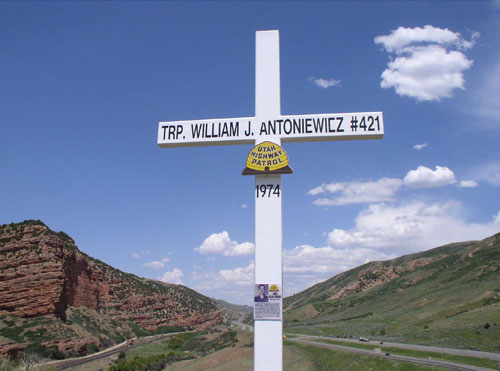Peter walked on water. Peter and John healed the lame man in the Temple. Peter and Paul raised the dead. They and the other disciples went out and duplicated the powers of our Lord with healings and mighty signs and wonders.
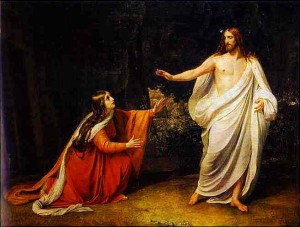
But there was one miracle that Jesus performed that they could not duplicate: raise Himself from the grave to everlasting life!
This was the greatest miracle of all time.
Nothing can even come close to it. It is beyond the scope of the word miracle. There is no word for it. It is a one-time event.
Jesus had told the disciples on a number of occasions that He would return from the grave. He told them, “Behold, we go up to Jerusalem; and the Son of man shall be betrayed unto the chief priests and unto the scribes, and they shall condemn him to death, And shall deliver him to the Gentiles to mock, and to scourge, and to crucify him: and the third day he shall rise again” (Matthew 20:18-19).
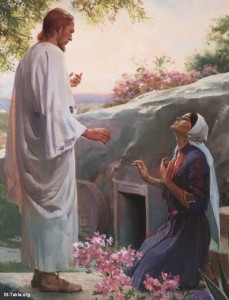
But when it happened, it was so astonishing that Jesus’ most repeated phrase after His resurrection was “Fear not.”
He had proclaimed in the Beatitudes: “Blessed are the pure in heart; for they shall see God” (Matthew 5:8).
Thus it should be no surprise the very first of His followers who were privileged to see our risen Lord were those pure in heart, the women, the ones who did not forsake Him. Their consciences were clear. They had been faithful despite the dangers – Mary Magdalene and the other women who stood under the cross as He breathed His last.
The doubting disciples – those upon whom the task of leading the Church would fall – had to be told by the women that Jesus was alive!
Did Jesus appear to His mother? One would have thought that she would have been the first. Who could have been more sorrowful at His death than she? After all. who had stood by Him longer than she? Who could have possibly loved Him more than she?
We know that when the women came to the tomb, Jesus was not only not in the tomb, He was nowhere to be found. Where was He? Waiting out in the garden for them.
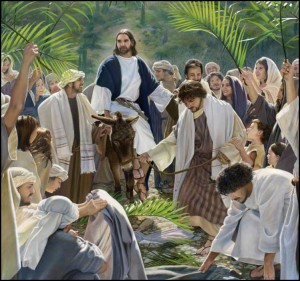
Consider what Jesus’ followers had just been through. It must have seemed the end of the world – the devastation of all their hopes.
What an incredible reception they’d had when Jesus had returned to Jerusalem in what today we refer to as His “Triumphal Entry.” Crowds lined the streets and laid down their coats and palm branches in His path. Yet only a brief time later, they were howling for His execution.
The disciples just didn’t understand what was about to happen. During the Last Supper, they seemed puzzled by His words – and didn’t suspect why Judas Iscariot slipped out early. When Jesus asked them to pray with Him in the Garden of Gethsemane, they took naps.
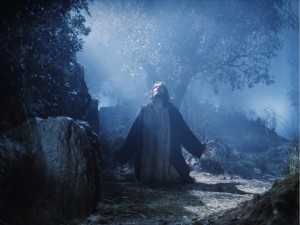
At the foot of the Mount of Olives, near the path over the hill toward Bethany, today there remains a grove of olive trees, still called the Garden of Gethsemane.
Gethsemane means “oil press.” Jesus often went to this place with His disciples, because of its quiet seclusion. Into this garden He led the disciples, and outside He left eight, saying to them, “Sit here, while I go inside and pray.”
He took with Him the three chosen ones, Peter, James and John, and went within the olive grove.
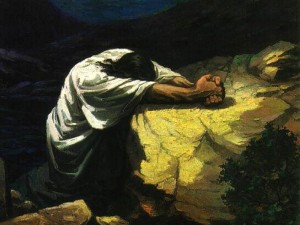
Jesus knew that in a little while Judas would be back with a band of soldiers to seize Him, that within a few hours He would be beaten and ridiculed and condemned to die in agony.
The thought of what He was to suffer came upon Him and filled His soul with grief. However, something much heavier was upon His shoulders. He was about to become the sacrificial Lamb, bearing the terrible weight of mankind’s sins. He who had never sinned was, as the Bible says, about to become guilty of every sin ever committed.
It was a terrible burden no other man has ever had to bear. He said to Peter, and James, and John, “My soul is filled with sorrow; a sorrow that almost kills Me. Stay here and watch while I pray.”
He went a little further among the trees and prostrated Himself down upon the ground. There, He cried out “O, My Father, if it be possible, let this cup pass away from Me; nevertheless, not as I will, but as You will!”
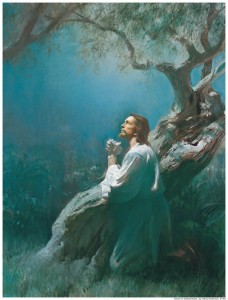
So earnest was His grief and so great His suffering that there came out upon His face great drops of sweat like blood, falling upon the ground.
After praying for a time, He rose and went to His three disciples, only to find them snoring. He awakened them and said to Peter, “What, could you not watch with Me one hour? Watch and pray, that you may not go into temptation.”
He left them and went a second time into the grove and fell on His knees. There, He prayed again, saying, “O, My Father, if this cup cannot pass away, and I must drink it, then Thy will be done.”
He came again to the three dozing disciples.
This time, He did not wake them. He went back into the garden and alone as never before, prayed.
God did not turn His face away. An angel from heaven came to Him and gave Him strength.
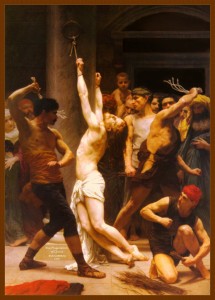 When the soldiers appeared with Judas, the disciples were jolted awake. They were stunned. They were unprepared for this. Timidly, Peter followed Jesus, but was filled with fear. As he hesitated in an outer courtyard, he was confronted by a little girl who recognized his Galilean accent. Vehemently, he denied even knowing who Jesus was – three times.
When the soldiers appeared with Judas, the disciples were jolted awake. They were stunned. They were unprepared for this. Timidly, Peter followed Jesus, but was filled with fear. As he hesitated in an outer courtyard, he was confronted by a little girl who recognized his Galilean accent. Vehemently, he denied even knowing who Jesus was – three times.
Such shame he felt when Jesus was brought out into the courtyard, beaten, wearing a mock purple robe and a painful crown of thorns.
Imagine Peter’s confusion. This made no sense! Jesus was the Messiah! How could this be happening? How could the Son of God be mocked by King Herod Antipas, challenged to do magic tricks to prove He was God’s Son.
Now Pontius Pilate questioned Jesus asking, “Are you a king?”
Jesus answered, “My kingdom is not an earthly one, thou sayest that I am a king. To this end I was born and for this cause came I into the world, that I should bear witness unto the truth. Everyone that is of the truth heareth my voice.”
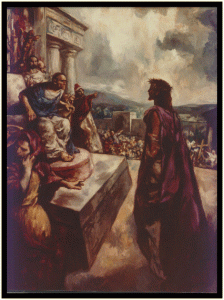
Disinterested in what seemed a Jewish internal dispute, Pilate shrugged. To him, Jesus appeared to be some kind of religious mystic. Pilate declared, “I can find no fault in him at all.”
“Crucify Him!” screamed the mob.
Puzzled, not wanting to cause a political situation, Pilate gave them a choice of who should go free as was traditional on the eve of Passover; Jesus Christ or a notorious murderer, Barabas. The masses demanded the death of the Nazarene.
Pilate was slipped a note from his wife, Claudia Propula. She’d been warned by God in a dream that her husband should not condemn Jesus. He ignored her. Tradition says days later, she became a Christian.
Pilate, the crafty politician, still puzzled by the whole thing, washed his hands of the matter. The mob had unsettled him, shouting for Christ’s death. Their vicious bloodlust filled their faces as they screamed, “Crucify Him! Crucify Him!” He didn’t want to be responsible for an uprising, so he gave them what they wanted.
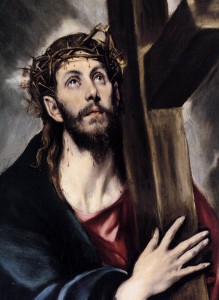
The soldiers tore away Jesus’ purple robe, and forced him to take up the cross. Just outside the gate to Pilate’s palace, Jesus stumbled and fell. Ordinarily the procession would have gone through the main part of the city to display the condemned prisoner to the entire populace. However, the Sabbath was the next day and Jesus had to be executed before sunset.
Agony etched the face of Mary, as she watched her Son’s terrible agony. She knew without a doubt just who He was. It had only been 33 years since an angel had told her she would be the only virgin in human history to bear the Son of the Almighty. She had marveled as the shepherds told her about the great choir of angels. Quietly she received gifts of gold, frankincense and myrrh from eastern wisemen.
How well she remembered her 12-year-old son being completely at home in the Holy Temple, having a great time discussing the prophets with the scribes and priests – who were astonished that a pre-adolescent was so well-versed in the mysteries of God.
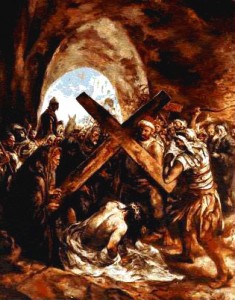
Yes, she knew who He was. Impatiently, she had watched – finally advising the father of the bride at Cana who had not adequately prepared for his daughter’s reception to ask Jesus what he should do.
Now, she looked at His torn back, lashed by the Roman whip, His forehead pierced by the thorns and His agony as He struggled back to his feet, trying to shoulder the cross.
He looked up at her. In mute horror, Mary must have wondered what God was doing.
The Roman soldiers forced Him to continue, taunted by the crowds, reviled by the very people who had hailed Him just days earlier. But it became apparent that Jesus was becoming rapidly weaker and might not survive the rest of the journey to Calvary.
So, the centurion in charge took matters into his own hands. It was his duty to deliver a live criminal for crucifixion, not a dead one. Surveying the crowd, he chose an African bystander, Simon of Cyrene, to carry the cross for Jesus.
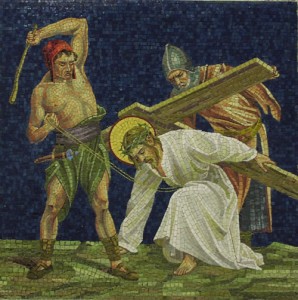 There are stories wrapped in tradition about that terrible day. The Bible does not record the legend of Veronica, also called Sheraphia, the wife of an influential member of the Jewish Sanhedran. Tradition has it that she had long been a secret follower of Jesus. Crying out as she saw His agony, she rushed to help Him. She wiped the face of the Master with her veil.
There are stories wrapped in tradition about that terrible day. The Bible does not record the legend of Veronica, also called Sheraphia, the wife of an influential member of the Jewish Sanhedran. Tradition has it that she had long been a secret follower of Jesus. Crying out as she saw His agony, she rushed to help Him. She wiped the face of the Master with her veil.
Tradition also holds that there was construction going on along the route and Jesus fell for the second time. Simon of Cyrene clinched his eyes shut against the awful sight of the Roman soldiers lashing at the pitiful, prostrate body lying in the street. In the distance, smoke was rising from the Temple – burnt offerings being made in observance of the Passover.
Little did they know that the perfect Lamb was about to be slain in fulfullment to all the prophecies.
Again, it is tradition, not the biblical record, that says the procession paused for a moment to enable the rear guard to catch up. Here at the top of a small rise, a group of women risked arrest by weeping and crying out to Jesus.
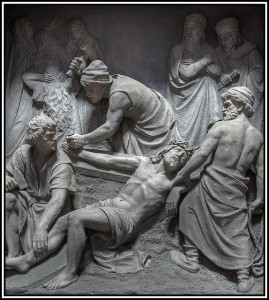
His waning strength now almost depleted, Jesus fell for the third time at the foot of Calvary or Golgotha as the execution mound was called. Both words signify “skull-like” or “place of the skulls”; Calvary is the Greek word and Golgotha the Hebrew. The skulls and bones strewn about were those of victims of earlier crucifixions, left to putrefy among the other dumped garbage.
Jesus made a superhuman effort to gather the strength for the remaining climb to the top. The slow, agonizing ascent to Calvary was completed. The crown of thorns was torn from His head so the Roman soldiers could strip Him of His outer garments before jamming the crown back on His head.
Examining the blood-smeared robe, the soldiers found it to be seamless and therefore quite a prize. Meanwhile, workers drilled holes in the cross to ease the entry of the blunt nails to be driven through His hands.
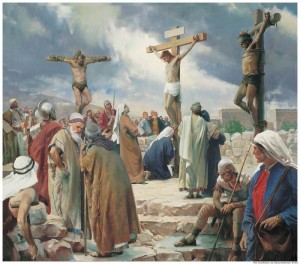
He was laid on the cross. A brutal soldier drove a nail through the Savior’s hand while another soldier held down His feet. Our Lord writhed in agony. Over the pounding of the hammer, the soldiers bellowed orders, pushing the people back. The disciple John stood with Mary and the other women, watching, but unable to intervene.
We all know the story of Christ’s agony on the cross. His pardon of the thief on the cross next to Him. The mocking Roman guards. His final words of forgiveness.
What we may not have considered is our Lord’s total devastation. Sinless, He was bearing the intentionally committed evil of the world – alone, deserted. The Bible indicates that even God the Father briefly turned His face away, unwilling to look at such wickedness, leaving Jesus utterly, terribly alone.
History tells us that in the instant Jesus gave up His mortal life, thunder crashed, lightning split the clouds and a tremendous earthquake shook the land with a roar. The thick Temple veil separating the Holy of Holies was split from top to bottom. A darkness like midnight came upon Jerusalem at three o’clock and lasted for the rest of the day.
The frightful impact of the wrath of God was voiced by the Roman Centurion when he bowed his head and murmured, “Surely, this man was the Son of God.”
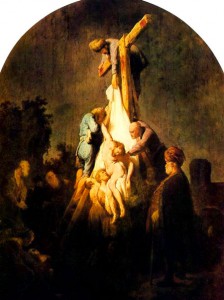
And then it was over. Nicodemus, a Pharisee who secretly believed in Jesus, volunteered to help the disciple John take the body down and put it into a donated tomb owned by Joseph of Arimathea. Lovingly, they removed the nails and carefully lowered the precious body into the arms of His mother and the other women.
After being embalmed with spices and wrapped with linen, Jesus was sealed in the tomb. Roman soldiers then guarded the tomb to keep any followers of Jesus from stealing His body.
And there He rested … until Sunday morning. Early, before dawn, Mary Magdalene returned to apply perfumes to the body – only to find the stone rolled away. She was anguished! She was joined by Mary and the other women. They returned to find His body gone from the tomb.
What had happened? The angel of the Almighty God had descended from heaven and rolled back the stone from the door.
There, he sat upon it. His countenance was like lightning, the Bible tells us. His raiment was wh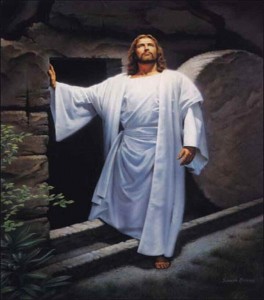 ite as snow. And for fear of him the soldiers shook and collapsed like dead men.
ite as snow. And for fear of him the soldiers shook and collapsed like dead men.
And there in the garden near the tomb, Jesus appeared to the women. They rejoiced. He was risen! They ran to find the disciples.
Imagine the fear and joy. Confronted with an empty tomb, suddenly the unfaithful disciples were face to face with the Messiah, who had obeyed His Father and atoned for their sins and those of the entire world.
Their Redeemer was alive! They were forgiven. They fell at His feet.
What a moment that must have been!
Hallelujah!
He is risen!
